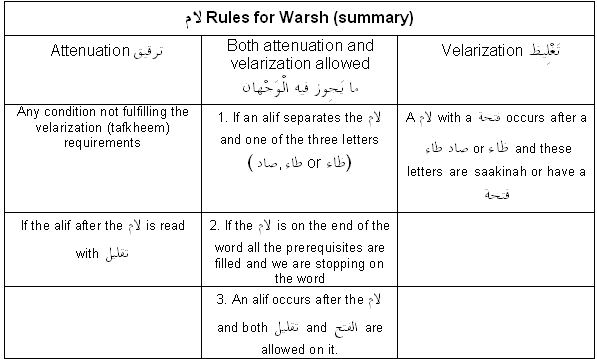13.
 Heaviness of the
Heaviness of the

The terms
 and
and
 are synonyms. The scholars tend to use the word
are synonyms. The scholars tend to use the word
 for velarization of the letter
for velarization of the letter  , and tend to use the word
, and tend to use the word
 for velarization of the
راء. Warsh has
for velarization of the
راء. Warsh has
 of the
of the  in the following
conditions:
in the following
conditions:
A.
 has a
has a
 .
.
B.
 is preceded by
is preceded by
 ,
,
 , or
, or
 .
.
C. These three letters ( ,
,
 , or
, or
 ) have
either a
) have
either a
 or a
sukoon.
or a
sukoon.
If all three of these
conditions are met, then there is
 of the
of the
 .
Examples are:
.
Examples are:



 .
.
There are two ways of reading the following words (meaning with
tafkheem of the  and without) because of the alif between the letter causing the tafkheem and the
and without) because of the alif between the letter causing the tafkheem and the
 :
:

 in aayah surah
al-Baqarah
, and
in aayah surah
al-Baqarah
, and
 in aayah 128 of surah an-Nissaa'.
in aayah 128 of surah an-Nissaa'.
There are also two allowed
ways of reading words fulfilling the conditions, but the letter
 is the last letter of
the word, and one is stopping on it with an incidental sukoon. Examples of this are
when stopping on the following words:
is the last letter of
the word, and one is stopping on it with an incidental sukoon. Examples of this are
when stopping on the following words:

 .
.
If there is
an alif following the  and both
and both
 and
and
 are allowed when stopping and/or continuing
on the alif, then two ways are allowed for the
are allowed when stopping and/or continuing
on the alif, then two ways are allowed for the  , when reading with
, when reading with
 there is
there is
 of the
of the  and when reading with
and when reading with
 there is tarqeeq of the
there is tarqeeq of the  . Examples:
. Examples:
 (Al-Baqarah 125) ,
(Al-Baqarah 125) ,

(Al-Israa 18, Al-Layl 15) .
If the only way of reciting the word is with
 , then there is only tarqeeq of
, then there is only tarqeeq of
 such as when stopping the end of the
aayaat on the 10 special suwar that end in
such as when stopping the end of the
aayaat on the 10 special suwar that end in
 in the reading of Warsh:
in the reading of Warsh:
 (Al-Qiyaamah 31) .
(Al-Qiyaamah 31) .
